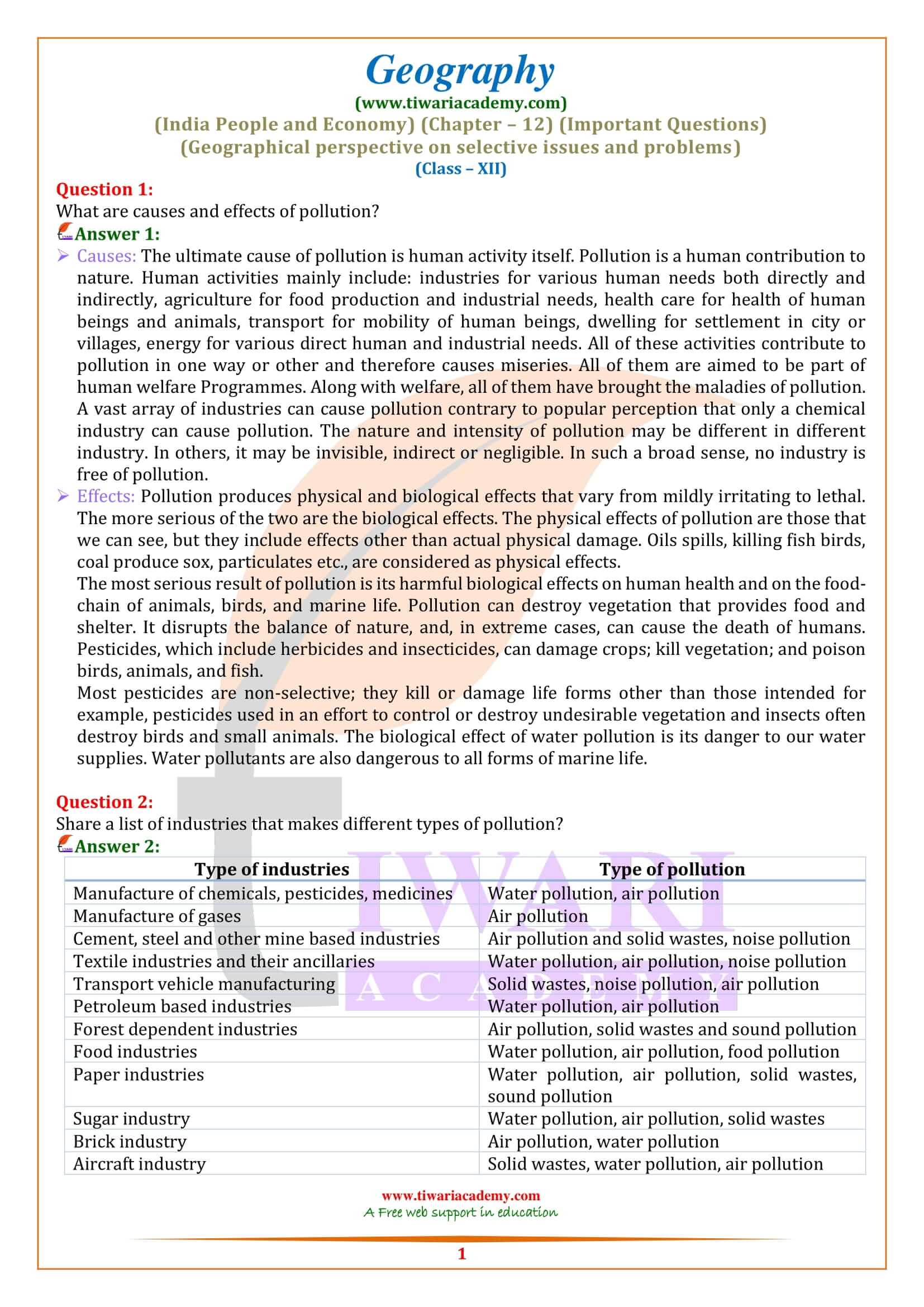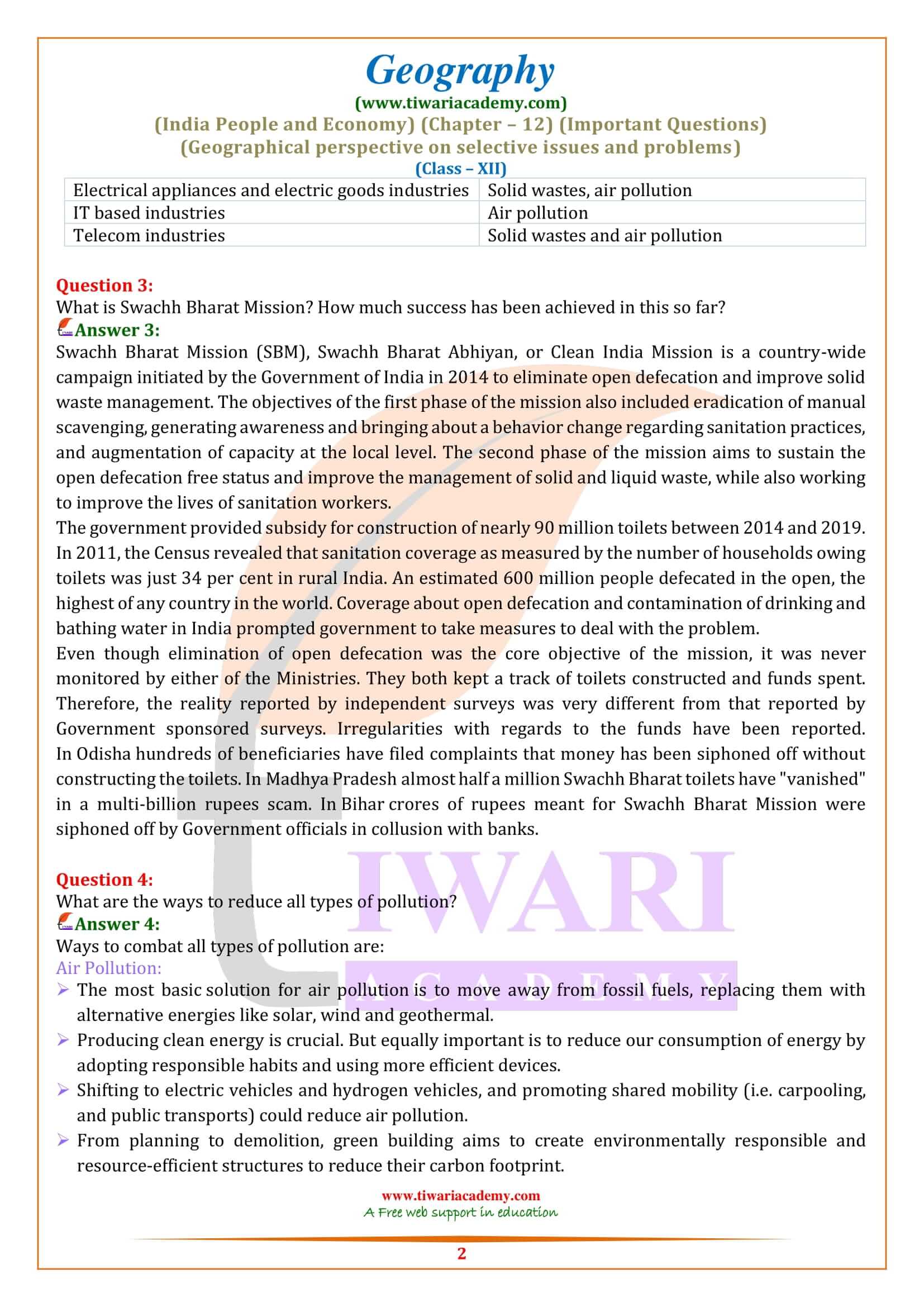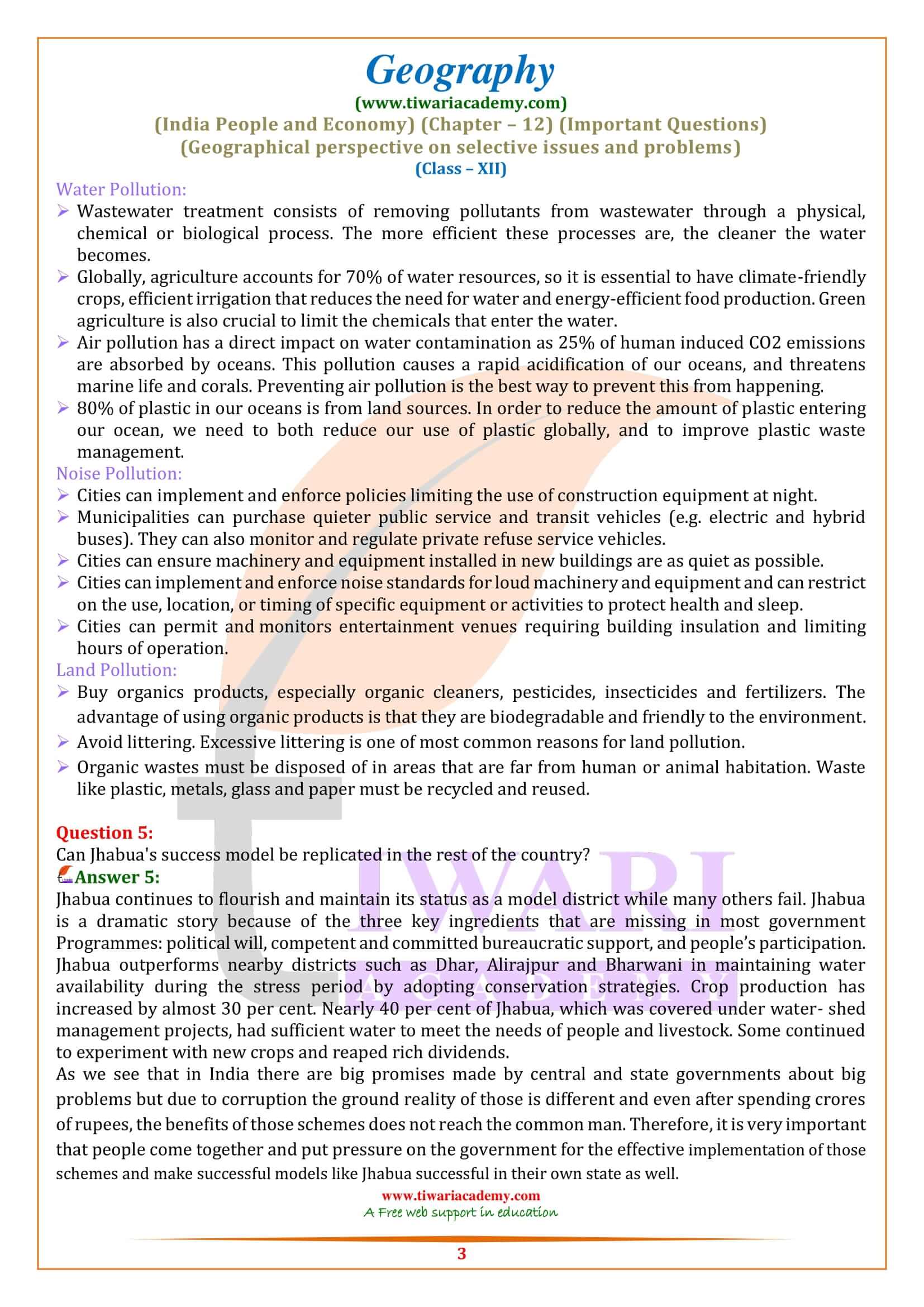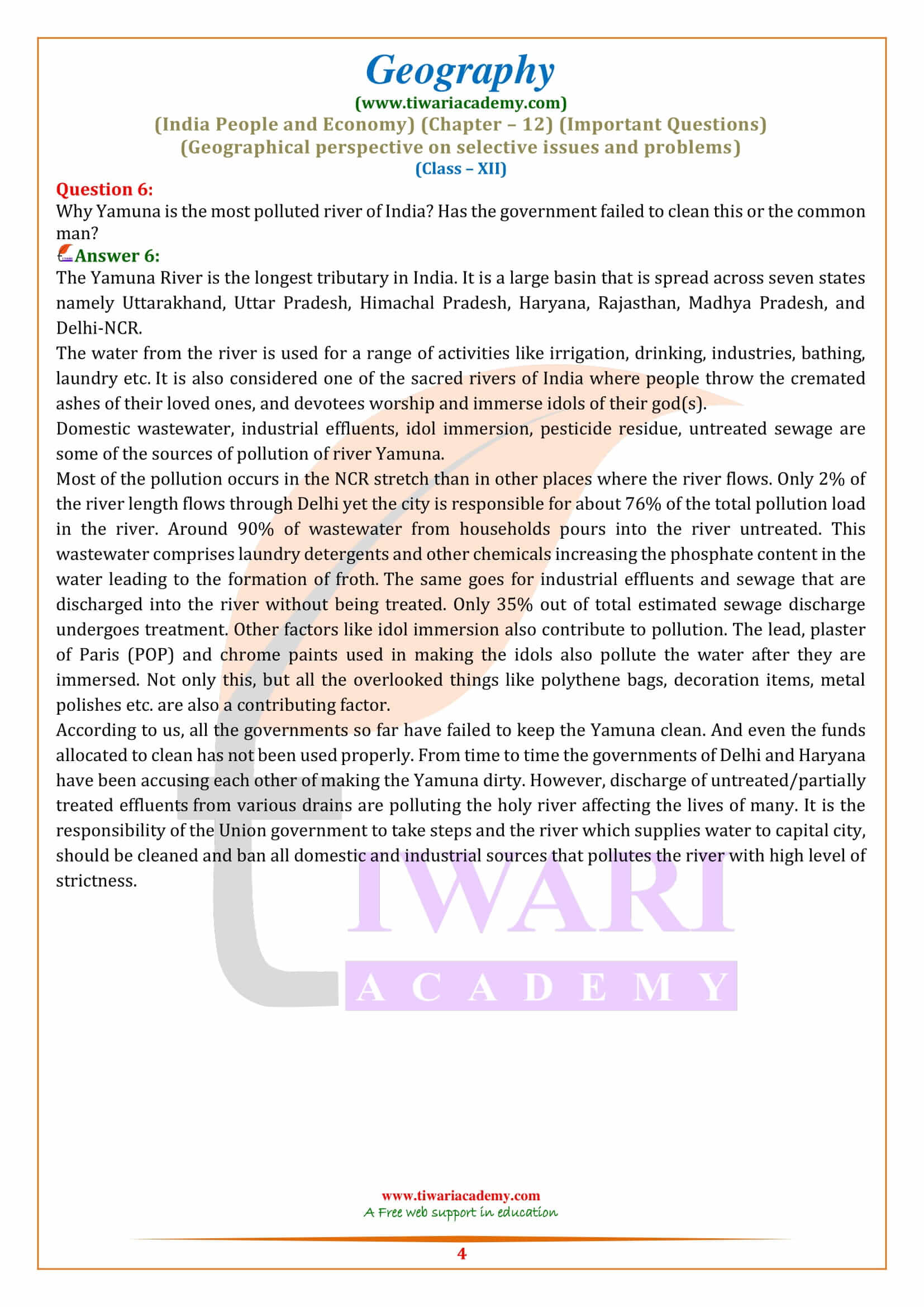Class 12 Geography Part 2 Chapter 12 Important Questions of Geographical Perspective on Selected Issues and Problems for new academic session 2024-25. Class 12 Geography Part 2 India People and Economy chapter 12 extra questions helps the student to revise the chapter during the exams.
Class 12 Geography Chapter 12 Important Questions
Class 12 Geography Chapter 12 Important Extra Question Answers
What are causes and effects of pollution?
Causes: The ultimate cause of pollution is human activity itself. Pollution is a human contribution to nature. Human activities mainly include: industries for various human needs both directly and indirectly, agriculture for food production and industrial needs, health care for health of human beings and animals, transport for mobility of human beings, dwelling for settlement in city or villages, energy for various direct human and industrial needs.
All of these activities contribute to pollution in one way or other and therefore causes miseries. All of them are aimed to be part of human welfare Programmes. Along with welfare, all of them have brought the maladies of pollution.
A vast array of industries can cause pollution contrary to popular perception that only a chemical industry can cause pollution. The nature and intensity of pollution may be different in different industry. In others, it may be invisible, indirect or negligible. In such a broad sense, no industry is free of pollution.
Effects: Pollution produces physical and biological effects that vary from mildly irritating to lethal. The more serious of the two are the biological effects. The physical effects of pollution are those that we can see, but they include effects other than actual physical damage. Oils spills, killing fish birds, coal produce sox, particulates etc., are considered as physical effects.
The most serious result of pollution is its harmful biological effects on human health and on the food-chain of animals, birds, and marine life. Pollution can destroy vegetation that provides food and shelter. It disrupts the balance of nature, and, in extreme cases, can cause the death of humans. Pesticides, which include herbicides and insecticides, can damage crops; kill vegetation; and poison birds, animals, and fish.
Most pesticides are non-selective; they kill or damage life forms other than those intended for example, pesticides used in an effort to control or destroy undesirable vegetation and insects often destroy birds and small animals. The biological effect of water pollution is its danger to our water supplies. Water pollutants are also dangerous to all forms of marine life.
Can Jhabua’s success model be replicated in the rest of the country?
Jhabua continues to flourish and maintain its status as a model district while many others fail. Jhabua is a dramatic story because of the three key ingredients that are missing in most government Programmes: political will, competent and committed bureaucratic support, and people’s participation. Jhabua outperforms nearby districts such as Dhar, Alirajpur and Bharwani in maintaining water availability during the stress period by adopting conservation strategies. Crop production has increased by almost 30 per cent. Nearly 40 per cent of Jhabua, which was covered under water- shed management projects, had sufficient water to meet the needs of people and livestock. Some continued to experiment with new crops and reaped rich dividends.
As we see that in India there are big promises made by central and state governments about big problems but due to corruption the ground reality of those is different and even after spending crores of rupees, the benefits of those schemes does not reach the common man. Therefore, it is very important that people come together and put pressure on the government for the effective implementation of those schemes and make successful models like Jhabua successful in their own state as well.
What is Swachh Bharat Mission? How much success has been achieved in this so far?
Swachh Bharat Mission (SBM), Swachh Bharat Abhiyan, or Clean India Mission is a country-wide campaign initiated by the Government of India in 2014 to eliminate open defecation and improve solid waste management. The objectives of the first phase of the mission also included eradication of manual scavenging, generating awareness and bringing about a behavior change regarding sanitation practices, and augmentation of capacity at the local level. The second phase of the mission aims to sustain the open defecation free status and improve the management of solid and liquid waste, while also working to improve the lives of sanitation workers.
The government provided subsidy for construction of nearly 90 million toilets between 2014 and 2019. In 2011, the Census revealed that sanitation coverage as measured by the number of households owing toilets was just 34 per cent in rural India. An estimated 600 million people defecated in the open, the highest of any country in the world. Coverage about open defecation and contamination of drinking and bathing water in India prompted government to take measures to deal with the problem.
Even though elimination of open defecation was the core objective of the mission, it was never monitored by either of the Ministries. They both kept a track of toilets constructed and funds spent. Therefore, the reality reported by independent surveys was very different from that reported by Government sponsored surveys. Irregularities with regards to the funds have been reported. In Odisha hundreds of beneficiaries have filed complaints that money has been siphoned off without constructing the toilets. In Madhya Pradesh almost half a million Swachh Bharat toilets have “vanished” in a multi-billion rupees scam. In Bihar crores of rupees meant for Swachh Bharat Mission were siphoned off by Government officials in collusion with banks.
Why Yamuna is the most polluted river of India? Has the government failed to clean this or the common man?
The Yamuna River is the longest tributary in India. It is a large basin that is spread across seven states namely Uttarakhand, Uttar Pradesh, Himachal Pradesh, Haryana, Rajasthan, Madhya Pradesh, and Delhi-NCR.
The water from the river is used for a range of activities like irrigation, drinking, industries, bathing, laundry etc. It is also considered one of the sacred rivers of India where people throw the cremated ashes of their loved ones, and devotees worship and immerse idols of their god(s).
Domestic wastewater, industrial effluents, idol immersion, pesticide residue, untreated sewage are some of the sources of pollution of river Yamuna.
Most of the pollution occurs in the NCR stretch than in other places where the river flows. Only 2% of the river length flows through Delhi yet the city is responsible for about 76% of the total pollution load in the river. Around 90% of wastewater from households pours into the river untreated. This wastewater comprises laundry detergents and other chemicals increasing the phosphate content in the water leading to the formation of froth. The same goes for industrial effluents and sewage that are discharged into the river without being treated. Only 35% out of total estimated sewage discharge undergoes treatment. Other factors like idol immersion also contribute to pollution. The lead, plaster of Paris (POP) and chrome paints used in making the idols also pollute the water after they are immersed. Not only this, but all the overlooked things like polythene bags, decoration items, metal polishes etc. are also a contributing factor.
According to us, all the governments so far have failed to keep the Yamuna clean. And even the funds allocated to clean has not been used properly. From time to time the governments of Delhi and Haryana have been accusing each other of making the Yamuna dirty. However, discharge of untreated/partially treated effluents from various drains are polluting the holy river affecting the lives of many. It is the responsibility of the Union government to take steps and the river which supplies water to capital city, should be cleaned and ban all domestic and industrial sources that pollutes the river with high level of strictness.






